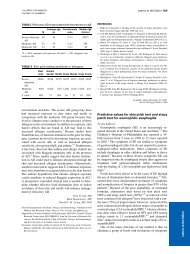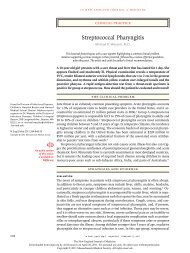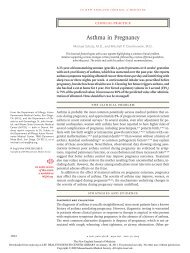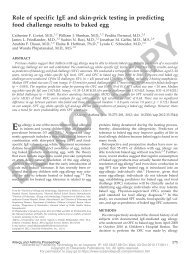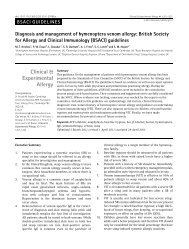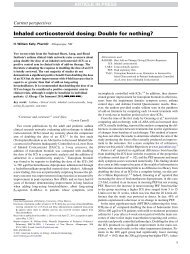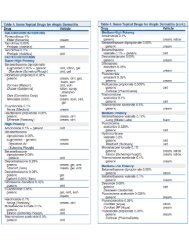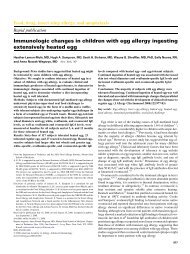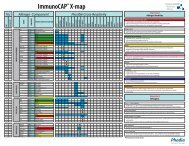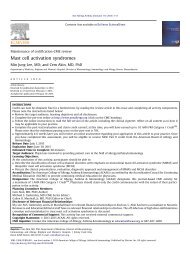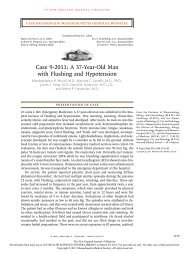CVID - Cunningham-Rundles JACI 2012.pdf - AInotes
CVID - Cunningham-Rundles JACI 2012.pdf - AInotes
CVID - Cunningham-Rundles JACI 2012.pdf - AInotes
Create successful ePaper yourself
Turn your PDF publications into a flip-book with our unique Google optimized e-Paper software.
1426.e2 CUNNINGHAM-RUNDLES AND MAGLIONEJ ALLERGY CLIN IMMUNOLMAY 2012vary in composition, each having an additive, such as an aminoacid, sorbitol, salt, or sugar, to prevent protein aggregations.These can influence the selection of a preparation for an individualpatient. Although there is one product very low in IgA that hasbeen used in subjects with anti-IgA antibodies, testing for anti-IgA antibodies is not generally done before starting immunoglobulinreplacement because of the rarity of clinically importantantibodies of this kind.The dosage of immunoglobulin for intravenous use is evaluatedby measuring trough IgG levels drawn before administration.Although an earlier goal of immunoglobulin replacement wasconsidered to be a trough serum value of around 600 mg/mL, E20 anumber of recent studies suggest that higher, even individualized,dosages might be beneficial. E21 For subcutaneous delivery, a sampledrawn just before a treatment can provide this value. Althoughtrough levels of 1000 mg/dL correlated with a 5-fold decrease inpneumonia when compared with patients at 500 mg/dL in onemeta-analysis, E21 comprehensive reduction in the incidence ofmultiple infections is not always associated with higher troughvalues. E22 Contributing to the inherent complexity of dosingIgG replacement are the physiologic differences among patientsrelating to immunoglobulin production and metabolism, makingthe extrapolation of a single goal IgG trough for all patients inappropriate.Goal IgG troughs are dictated by the baseline serumIgG level, as well as the extent of functional antibody responses. E5Accordingly, a goal trough IgG level should be determined basedon the preintervention baseline: a patient with profoundly compromisedIgG levels might see noted clinical benefit from agoal trough of 600 mg/dL of IgG, whereas a patient with slightlybelow-normal IgG levels yet profoundly compromised specificantibody responses might need a significantly higher trough levelto achieve clinical benefit. In other words, immunoglobulinreplacement should be individualized, with dose adjustment consideredbased on clinical course. Moreover, physiologic determinants,such as neonatal Fc receptor expression, might affect thehalf-life of immunoglobulin, consequently requiring higher dosesto achieve clinical response in certain patients. E23 The neonatal Fcreceptor is a broadly expressed MHC class I–like molecule thatfunctions to increase IgG half-life through protection from catabolism.E24 Once established on immunoglobulin replacement therapy,IgG trough levels are measured every 6 to 12 months toensure adequate dosing and administration.THE CASE REVISITEDFinally, a consulting hematologist who saw this patient in 2011decided to refer her for immune deficiency evaluation based onher history of recurrent sinusitis, shingles, hepatic and pulmonarynodules, and ITP. The serum immunoglobulins were examined,and antibody defects were documented. On the basis of thediagnosis of <strong>CVID</strong>, she was started on 400 mg/kg IVIG once amonth. The primary goal of this therapy will be to reduce theincidence of sinus infections and reduced use of antibiotics andcorticosteroids. Although episodes of ITP are reduced in patientswith <strong>CVID</strong> who have had recurrent bouts of thrombocytopenia,E25 pulmonary nodules are not likely to be altered by this therapy,as for most of the other noninfectious complications of<strong>CVID</strong>. E1,E26REFERENCESE1. Chapel H, <strong>Cunningham</strong>-<strong>Rundles</strong> C. Update in understanding common variable immunodeficiencydisorders (<strong>CVID</strong>s) and the management of patients with theseconditions. Br J Haematol 2009;145:709-27.E2. Yel L. Selective IgA deficiency. J Clin Immunol 2010;30:10-6.E3. Busse PJ, Razvi S, <strong>Cunningham</strong>-<strong>Rundles</strong> C. Efficacy of intravenous immunoglobulinin the prevention of pneumonia in patients with common variable immunodeficiency.J Allergy Clin Immunol 2002;109:1001-4.E4. Pourpak Z, Aghamohammadi A, Sedighipour L, Farhoudi A, Movahedi M, GharagozlouM, et al. Effect of regular intravenous immunoglobulin therapy on preventionof pneumonia in patients with common variable immunodeficiency.J Microbiol Immunol Infect 2006;39:114-20.E5. <strong>Cunningham</strong>-<strong>Rundles</strong> C. How I treat common variable immune deficiency. Blood2010;116:7-15.E6. Espanol T, Catala M, Hernandez M, Caragol I, Bertran JM. Development of a commonvariable immunodeficiency in IgA-deficient patients. Clin Immunol Immunopathol1996;80:333-5.E7. van de Ven AA, Compeer EB, van Montfrans JM, Boes M. B-cell defects in commonvariable immunodeficiency: BCR signaling, protein clustering and hardwiredgene mutations. Crit Rev Immunol 2011;31:85-98.E8. Park JH, Resnick ES, <strong>Cunningham</strong>-<strong>Rundles</strong> C. Perspectives on common variableimmune deficiency. Ann N Y Acad Sci 2012;1246:41-9.E9. Notarangelo LD, Fischer A, Geha RS, Casanova JL, Chapel H, Conley ME, et al.Primary immunodeficiencies: 2009 update. J Allergy Clin Immunol 2009;124:1161-78.E10. Lack G, Ochs HD, Gelfand EW. Humoral immunity in steroid-dependent childrenwith asthma and hypogammaglobulinemia. J Pediatr 1996;129:898-903.E11. Fedor ME, Rubinstein A. Effects of long-term low-dose corticosteroid therapy onhumoral immunity. Ann Allergy Asthma Immunol 2006;97:113-6.E12. Lee AH, Levinson AI, Schumacher HR Jr. Hypogammaglobulinemia and rheumaticdisease. Semin Arthritis Rheum 1993;22:252-64.E13. Hayman G, Bansal A. Antibody deficiency associated with carbamazepine. BMJ2002;325:1213.E14. Azar AE, Ballas ZK. Reversible panhypogammaglobulinemia associated with theantiepileptic agent levetiracetam. Ann Allergy Asthma Immunol 2008;101:108-9.E15. Knight AK, <strong>Cunningham</strong>-<strong>Rundles</strong> C. Oxcarbazepine-induced immunoglobulindeficiency. Clin Diagn Lab Immunol 2005;12:560-1.E16. Pereira LF, Sanchez JF. Reversible panhypogammaglobulinemia associated withphenytoin treatment. Scand J Infect Dis 2002;34:785-7.E17. Ardeniz O, <strong>Cunningham</strong>-<strong>Rundles</strong> C. Granulomatous disease in common variableimmunodeficiency. Clin Immunol 2009;133:198-207.E18. Yong PF, Thaventhiran JE, Grimbacher B. ‘‘A rose is a rose is a rose,’’ but <strong>CVID</strong>is Not <strong>CVID</strong> common variable immune deficiency (<strong>CVID</strong>), what do we know in2011? Adv Immunol 2011;111:47-107.E19. <strong>Cunningham</strong>-<strong>Rundles</strong> C, Bodian C. Common variable immunodeficiency:clinical and immunological features of 248 patients. Clin Immunol 1999;92:34-48.E20. Orange JS, Hossny EM, Weiler CR, Ballow M, Berger M, Bonilla FA, et al. Useof intravenous immunoglobulin in human disease: a review of evidence by membersof the Primary Immunodeficiency Committee of the American Academy ofAllergy, Asthma and Immunology. J Allergy Clin Immunol 2006;117(suppl):S525-53.E21. Orange JS, Grossman WJ, Navickis RJ, Wilkes MM. Impact of trough IgG onpneumonia incidence in primary immunodeficiency: a meta-analysis of clinicalstudies. Clin Immunol 2010;137:21-30.E22. Lucas M, Lee M, Lortan J, Lopez-Granados E, Misbah S, Chapel H. Infectionoutcomes in patients with common variable immunodeficiency disorders: relationshipto immunoglobulin therapy over 22 years. J Allergy Clin Immunol2010;125:1354-60, e4.E23. Sachs UJ, Socher I, Braeunlich CG, Kroll H, Bein G, Santoso S. A variable numberof tandem repeats polymorphism influences the transcriptional activity of theneonatal Fc receptor alpha-chain promoter. Immunology 2006;119:83-9.E24. Kuo TT, Baker K, Yoshida M, Qiao SW, Aveson VG, Lencer WI, et al. NeonatalFc receptor: from immunity to therapeutics. J Clin Immunol 2010;30:777-89.E25. Wang J, <strong>Cunningham</strong>-<strong>Rundles</strong> C. Treatment and outcome of autoimmune hematologicdisease in common variable immunodeficiency (<strong>CVID</strong>). J Autoimmun2005;25:57-62.E26. Malamut G, Verkarre V, Suarez F, Viallard JF, Lascaux AS, Cosnes J, et al. Theenteropathy associated with common variable immunodeficiency: the delineatedfrontiers with celiac disease. Am J Gastroenterol 2010;105:2262-75.



